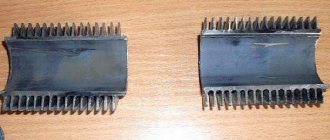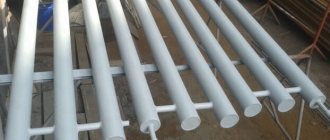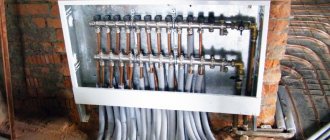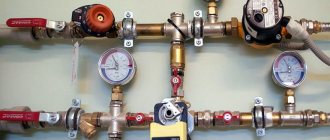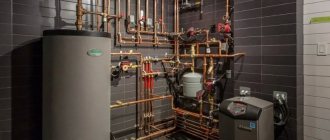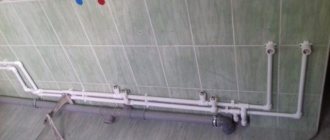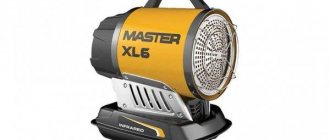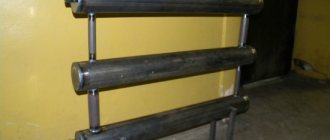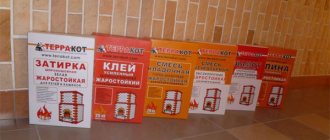For the heating system of large premises, it is not advisable to use conventional factory batteries and radiators. They have very little heat output and power. As an alternative, heating registers can be considered.
Heating devices called registers are several folding pipes located parallel to each other and connected to each other by jumpers. The coolant moves through the pipes, transferring heat to the iron walls of the register, which heat the air space in the room.
Water or antifreeze can be used as a coolant , which prevents the pipes of a disconnected system from freezing during the cool season. In independent heating registers with a cylindrical electric heater (TEH), the coolant can also be oil, then the independent register is considered the most powerful analogue of domestic oil radiators. They have become widespread due to their simplicity of design, reliability and a number of other advantages.
Serpentine registers (S-shaped)
Such registers have become quite popular. The design of these devices is quite simple: there are several sections that are connected by arcs, the diameter of which is close to the sectional ones. Due to this, the hydraulic pressure inside the device is significantly reduced. As a result, the register becomes a single unit, the entire surface of which is working, which significantly increases the efficiency of such devices.
Such heating registers made of smooth pipes usually contain a large amount of carbon. In addition, registers made of other materials can be found on the market: cast iron, alloy or stainless steel.
Combined instruments
Any device can be supplemented with a heating element, this way a combined heating device is obtained. It may not be associated with the system, and can be used separately.
If this is an isolated register with heating only from the heating element, then an expansion tank must be installed in its upper part. Its capacity should not be less than 10% of the capacity of the heating device. For steel registers, closed tanks should be installed.
Such steel structures are a great help in very cold times, when the heating capabilities of the boiler become limited. This option is very practical during the off-season, when it is not advisable to use the network at full capacity. After all, the room at this time only needs a little warming up.
Heat dissipation of registers
The heat transfer of registers made of steel pipes is the transfer of heat energy between the battery and the environment. Heating devices made from smooth pipes are less economically profitable.
The heat output of one meter of these structures is approximately 550 W, for a diameter from 3.2 to 21.9 cm. Welding installation work is recommended to be carried out so that mutual heating of the elements does not occur.
Under such conditions, the heat transfer rate becomes higher. If the register is assembled correctly, it becomes a reliable and durable steel heating device. Optimizing the heat transfer of a steel pipeline is decided at the design stage of its structure. To do this, use the following methods.
- Change of infrared radiation in the direction of increase. This can be done using paint.
- Ribs are installed, which also increases the required design performance.
But, there are cases when these indicators need to be reduced. Such actions are required by sections of the pipeline that pass outside residential premises. In these situations, the line is thermally insulated.
Calculations are carried out in this way: Q = K*F*dT. In this formula, Q denotes the thermal transfer coefficient, K is the thermal conductivity of steel materials, and F shows the length of the pipe taken for calculations. dT in this formula is the sum of the initial and residual temperatures, taking into account the room temperature.
Advantages and disadvantages of heating radiators
The designation dT is also called temperature difference. You can find out by adding the temperature at the outlet of the boiler equipment with the numbers at its input. The resulting readings are multiplied by 0.5 or divided by two. The room temperature is subtracted from this value.
If the steel heating pipeline is in insulating material, then the resulting number should be multiplied by the efficiency of the insulating material. It shows the percentage of thermal energy of the heating system released during the flow of the coolant.
If you want to design a system competently, then you should not select steel pipe assortment by eye. Correct calculations in this case not only make it possible to reduce the cost of construction work, but also to install a heating system that will work effectively for a long time.
Installation of steel registers
Installation of steel pipe registers is carried out in two ways. The first is threaded connections, and the second is through welding. In this matter, solutions are selected based on the total weight of the structure, its dimensions and characteristics.
The process itself is similar to the work when connecting radiators. The difference lies only in the geometric volumes of the structure. If there is a question of connecting the heating device to gravity networks, then the required slope standards must be observed.
The register must be tilted towards the movement of the coolant. For a pipeline with natural circulation, the described standards are not required.
The rules that are used for the correct connection of structures made of steel pipes are as follows:
- Minimum distances from windows and walls should be maintained. This distance is 20 cm. These indentations are needed for ease of repair maintenance.
- When using threaded connections to connect the device, it is recommended to use only gaskets made of paronite, or flax, which is used in plumbing work.
- Each steel appliance must be painted after installation. Otherwise, rust can form on its surface very quickly. At the same time, the thermal conductivity index is slightly reduced, but its maintenance-free service life is extended.
- All installation work should not be planned for the heating season. After a trial check and comparison of the calculated power of the device, it may be necessary to promptly make changes to the design.
Steel radiators. Why NOT use when replacing heating radiators with steel pipes.
Among the installation features, two mounting options can be distinguished. The first is by hanging the device on the wall, and the second is by mounting it on racks. The decision in this situation depends on the weight and dimensions of the device and the type of walls.
The combined version of fastening the structure has become very popular. To do this, first prepare the racks, and then attach them to the walls.
This method is suitable even for very heavy heating devices and guarantees a high level of safety. We must not forget about air vents; they complement every heating device. The collected air is released from the line through the air vent.
Sectional registers made of smooth pipes
Sectional registers are in very good demand among owners of private houses. Such devices consist of pipes that are interconnected and closed with plugs. The energy carrier passes through the top pipe, enters the next one, and ultimately ends up in the discharge line. To increase heat transfer, they try to make transitions between sections as close to the edge as possible. Interpipe plugs can be elliptical or flat. The inlet pipe can be made with a flange, thread or welding. The design of sectional registers includes a threaded fitting, to which a special vent is attached to remove air from the system. Pipes for sections can have different diameters (from 25 mm to 40 cm), so choosing the appropriate option is not difficult. Transition pipes usually have a smaller diameter. In addition, one of the most important operating conditions for such installations is the pressure in the system not exceeding 1 MPa.
Location options
Heating registers, depending on placement options, can be divided into two groups: portable and stationary. Portable systems are quite mobile, and they can be moved absolutely freely - if only there was power. And such systems are usually powered by electricity. Inside portable registers there are usually heating elements of different power, which provide heating of the energy carrier. Such units can be used both in the house and in the garage, at the dacha, at a construction site, etc. Stationary registers are demanding in terms of their location. Firstly, they require permanent mounting, and secondly, they need to be connected to a boiler, which will ensure heating of the coolant and its circulation through the system.
Material of manufacture
If you make a selection depending on the material of manufacture, then the registers can be classified into the following categories:
- Steel;
- Aluminum;
- Cast iron.
Which heating registers are best to choose? Steel registers became the most common. Their connection to the heating system is carried out by threading or welding. Such devices have good heat transfer and reasonable cost. Aluminum registers are much lighter than steel registers. In addition, they are resistant to corrosion, are made without connecting seams and have good heat dissipation. The main disadvantage of such devices is their very high price. Read also: “What types of heating registers are there – selection, calculation, characteristics.” Registers made of cast iron are connected to the heating system using a flange connection. They are quite easy to install and inexpensive. The disadvantages of cast iron products include low inertia, which significantly reduces the heating time of the registers.
What are there
Heating registers are made of different materials and have different shapes. Each has pros and cons.
What are they made from?
If we talk about materials, the most common is steel, or rather electric-welded steel pipes. Steel does not have the best heat transfer, but this is compensated by its low price, ease of processing, availability and a large selection of standard sizes.
It is very rare to find pipes made of stainless steel - for decent power a large number of pipes are required, and you have an idea how much stainless steel products cost. If they did, it was probably a long time ago. They also use galvanized steel, but it is more difficult to work with - you won’t be able to cook it.
Registers made of copper pipes have high heat transfer and an equally high price
- Requires neutral and clean coolant, free of solid particles
- the presence of other metals and alloys in the system is undesirable, except for compatible ones - bronze, brass, nickel, chromium, therefore all fittings and fittings will need to be made from these materials;
- Careful grounding is mandatory - without it, in the presence of water, electrochemical corrosion processes begin;
- the softness of the material requires protection - we need screens, covers, etc.
There are registers made of cast iron. But they are too bulky. In addition, they have a very large mass; no less massive racks need to be made for them. Plus, cast iron is fragile - one blow and it can crack. It turns out that this type of registers also needs protective covers, and they reduce heat transfer and increase cost. Moreover, installing them is complex and hard work. The advantages include high reliability and chemical neutrality: this alloy does not care what coolant it works with.
Cast iron finned tube registers
In general, copper and cast iron are not easy. So it turns out that the optimal choice is steel registers.
Calculation of the number of ribs
Heating registers must be calculated before purchasing them. The diameter of the pipes is very important: experts believe that pipes with a cross-sectional diameter in the range from 3 cm to 8 cm are suitable for a private house. This decision is determined by the fact that a conventional heating boiler is not capable of producing a larger amount of heat, so too large surfaces will not warm up completely . When making calculations, you need to pay attention to the length of one register rib and the heat transfer per meter of this length. For example, a meter-long pipe with a 6-centimeter cross-section can heat one square meter of area. When calculating the required number of edges, the result must be rounded up. The calculation of the number of heating registers must also take into account the characteristics of the building. For example, if a building has a large number of windows and doors, or if the walls are thin and poorly insulated, then the number of registers can be increased by 20-50%.
Best answers
drinker in the thorn bush:
If it is done aesthetically, it is better to use steel registers. If the registers are already mounted, close them behind decorative grilles.
Tech Box:
Smooth pipe circuit for good circulation and large volume of coolant.
Guy from the Future...:
The thermal conductivity of steel is 5 times less than that of aluminum. This means that with the same surface area of the device, the heat transfer of a steel device will be lower than that of aluminum. That is, you will have to make it 5 times larger in size..
Alexander:
The advantage of a smooth register with a large open surface area is that it remains efficient at low coolant temperatures, which cannot be said about modern aluminum ones at temperatures of 40 and below. The disadvantage of a register that has a high heat capacity is that this heat capacity prevents precise regulation. Now it remains to understand the wood-fired boiler and what fraction of the day the return temperature can be no higher than 40C or you have an automated pelletizer with a bunker for several days.
ip:
The best option for hydraulics together with registers is cast iron radiators. They have a slightly larger surface area relative to their volumes and linear dimensions compared to registers. If you need to heat a room without windows and without furniture along the walls, then registers will be good, and if there are windows , then you should put cast iron under them and it will block the heat loss of the room together with a DN50 pipe around the perimeter. The calculation of cast iron comes down to a set of sections in the ratio of two sections per linear meter of street wall for the first floor and one and a half for the second when the first one is heated. Good luck.
Anatoly Bananan:
I think that aluminum heating radiators teplofresh/catalog/alyuminievye-radiatory-otopleniya are best suited for a private home. There are two types of such radiators - cast and extruded. Extrusion radiators are more suitable for heating systems that use antifreeze liquid, since these radiators are more durable and are made of aluminum of fairly high purity.
Marya Lamyr:
I think that decorative stainless steel mesh will suit you perfectly, it is both beautiful and durable! By the way, decorvesta is a good store with similar products!
Pavel Mokov:
The thermal conductivity of steel is less than that of aluminum, so it’s better to take an aluminum radiator, look here tallosplav /catalog/alyuminievye_radiatory/.
Heating register installation
Installing heating registers usually does not require the help of a qualified specialist, but carrying out the operation yourself requires careful preparation. The most important thing is to ensure a reliable connection between the registers and the pipeline. The connection must be able to withstand a load of 10 MPa. When welding, it is very important to maintain good quality. For clarity, you can look at the photo, which shows a diagram of connecting heating registers.
It is best to place registers along the walls. A prerequisite for installing heating devices is maintaining a constant slope, which for registers is 0.05% of its length. In addition, registers should be installed closer to the floor surface.
The efficiency of the device will depend on a large number of factors. For example, a reduced main pipe diameter will increase resistance to the energy carrier, which will affect performance. The most commonly used systems are with the following parameters:
- pipe diameter: 25-160 mm;
- sectional adapters: from 30 mm;
- distance between main pipes: from 50 mm;
- maximum pressure: 10 MPa;
- material: steel.
Operating rules
There are no special requirements for the operation of registers compared to radiators:
They must be securely mounted on legs or strong brackets.
Any heating devices with water should not freeze.
If corrosion occurs, the damaged areas should be cleaned, covered with an anti-corrosion primer and painted in several layers.
Registers must not serve as a support for any loads.
It is necessary to ensure that the heating system does not become airy - this impairs its performance.
Advantages of heating registers
Heating registers have a number of advantages:
- possibility of using an individual drawing;
- The coolant can be not only water, but also heated steam;
- connecting the heating register to the system is extremely simple;
- excellent for heating large buildings because they have very good heat transfer;
- They're pretty cheap.
A homemade heating register is shown in the video: Conclusion Registers have already become good competitors to conventional heating radiators. Do-it-yourself heating registers allow you to save a lot, and these designs can work even in rooms with an aggressive environment.
